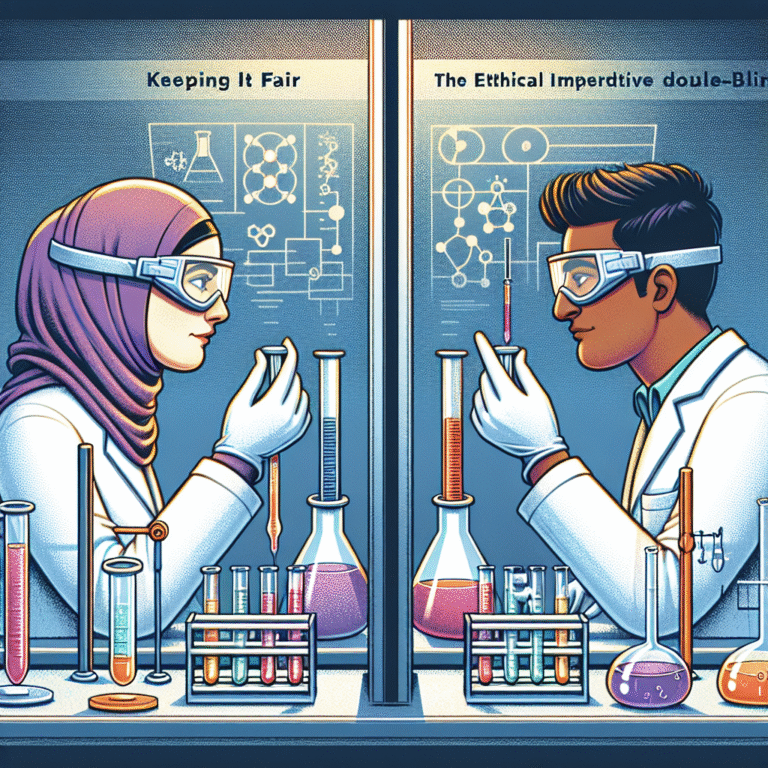
Introduction
In our increasingly health-conscious society, the importance of understanding medical studies cannot be overstated. Take a moment to consider how often you’ve encountered medical claims—whether in your doctor’s office, on social media, or in the news. Unfortunately, navigating the complex world of medical research can be overwhelming. Among the various methodologies employed, double-blind trials stand out as a gold standard in clinical research. This article is dedicated to Decoding Medical Studies: What You Need to Know About Double-Blind Trials—a vital topic for anyone eager to understand how medical decisions are shaped and informed.
Double-blind trials play a crucial role in how new treatments and medications are evaluated. By reducing bias and enhancing reliability, they help ensure that the outcomes are genuine reflections of the treatment’s efficacy. Let’s dive deep into the specifics—you’ll walk away armed with insights that will empower your understanding of medical studies.
What Are Double-Blind Trials?
Before we navigate the nuances of double-blind trials, let’s clarify what they are. In a double-blind trial, neither the participants nor the researchers know who is receiving the treatment and who is receiving a placebo. This structure minimizes bias and allows for a more accurate assessment of the treatment’s effectiveness.
The Basic Structure of a Double-Blind Trial
To further illustrate double-blind trials, here’s a simple breakdown:
| Component | Description |
|---|---|
| Participants | Volunteer patients (randomly assigned) |
| Intervention | The treatment being tested |
| Control Group | A group receiving a placebo |
| Blinding | Both parties are unaware of the treatment type |
In this framework, the allocation of participants to the control group or the treatment group is performed randomly, which is crucial for scientific rigor.
Why Are Double-Blind Trials Important?
Reducing Bias
Bias can skew the results of any study, and it comes in many forms. By ensuring that neither the participants nor the researchers know who is receiving what, double-blind trials reduce the expectancy bias, where participants or researchers might influence the outcomes based on their expectations.
Case Study: The Efficacy of Antidepressants
In a landmark double-blind trial assessing the efficacy of a new antidepressant, researchers discovered that patients who believed they were receiving active medication showed a significant improvement in symptoms compared to those receiving a placebo. Because neither the participants nor the researchers knew which group any participant was in, the results were deemed more credible.
Quality of Evidence
Double-blind trials are often cited as providing the highest quality of evidence when evaluating the efficacy of treatments. This is particularly true in the hierarchy of evidence types, where systematic reviews of double-blind randomized controlled trials sit at the top.
Table: Hierarchy of Evidence
| Level | Type of Study |
|---|---|
| 1 | Systematic Reviews |
| 2 | Randomized Controlled Trials |
| 3 | Cohort Studies |
| 4 | Case-Control Studies |
| 5 | Expert Opinion |
Real-World Applications: Vaccination Studies
One of the most compelling applications of double-blind trials has been in the field of vaccination. The trials conducted for several COVID-19 vaccines employed this methodology to assess safety and efficacy in a systematic manner. By blinding participants and researchers, the trials were able to confidently demonstrate that the vaccines significantly reduced the risk of severe illness.
The Process of Conducting Double-Blind Trials
Understanding the process will provide deeper insights into why double-blind trials are reliable. Here’s a high-level overview:
Step 1: Designing the Study
Researchers outline their hypothesis, plan participant recruitment, and define inclusion/exclusion criteria. The design must clearly indicate how randomization will occur.
Step 2: Randomization
Participants are randomly assigned to either the treatment group or the control group. This is typically done using a computer-generated randomization sequence to ensure comparability.
Step 3: Blinding
This phase ensures that neither the participant nor the researcher can influence the outcomes. This often involves using identical placebo pills or injections.
Step 4: Data Collection
Data are collected throughout the trial while maintaining the blinding. Researchers monitor for side effects and treatment efficacy, adhering strictly to predefined metrics.
Step 5: Statistical Analysis
Once the trial is complete, data is analyzed using statistical techniques to ascertain whether the results are statistically significant.
Step 6: Publication
Finally, results are compiled into a comprehensive report and submitted for peer review, making them available for scrutiny by the scientific community.
Common Misconceptions About Double-Blind Trials
While double-blind trials are often viewed as the pinnacle of clinical research, there are some common misconceptions that merit attention.
Misconception: All Trials Follow This Methodology
While double-blind trials are the gold standard, not all studies use this design. Different research questions may require varied methodologies, such as open-label trials or single-blind trials.
Misconception: Placebo Effects Aren’t Real
Some may argue that participants receiving a placebo do not actually experience any benefit. However, research consistently shows that the placebo effect can result in measurable improvements in symptoms, making the control group essential for comparison.
Evaluating Medical Literature: What to Look For
When you stumble upon a medical study, considering a few key factors will help you evaluate its quality—particularly in the context of double-blind trials.
1. Sample Size
Larger sample sizes generally yield more reliable results. Evaluate whether the study’s sample size is adequate to draw valid conclusions.
2. Randomization Process
Ensure that the randomization process was appropriately employed. This bolsters the study’s validity and reduces systemic biases.
3. Follow-Up Duration
How long were participants followed? Longer follow-up durations can provide insights into both the short-term and long-term impacts of the treatment.
4. Outcome Measures
Are the outcome measures defined and relevant to the hypothesis? Clear and objective measures enhance the credibility of results.
5. Peer Review Status
Published studies that have undergone rigorous peer review are generally more reliable than those that haven’t.
Conclusion
As we wrap up our examination of Decoding Medical Studies: What You Need to Know About Double-Blind Trials, it’s clear that double-blind trials occupy a crucial space in modern medicine. Understanding their structure, utility, and the processes involved is not just an academic exercise; it’s an essential skill for anyone seeking to make informed health choices in today’s complex medical landscape.
While navigating this field can seem daunting, remember this: knowledge is power. By grasping the fundamentals of double-blind trials, you will be better equipped to interpret medical research, discuss treatment options with your healthcare provider, and discern fact from fiction in the vast sea of health-related information.
FAQs
1. What is a double-blind trial?
A double-blind trial is a research study where neither the participants nor the researchers know who receives the treatment and who receives a placebo, reducing bias.
2. Why are double-blind trials used?
They are used to ensure that outcomes are not influenced by participants’ or researchers’ expectations, leading to more reliable results.
3. Are all clinical trials double-blind?
No, while double-blind trials are considered the gold standard, other methodologies exist, such as single-blind or open-label trials, depending on the research question being asked.
4. How does a placebo work?
A placebo is an inactive substance given to a control group, which can host a psychological response, often improving symptoms merely because the participant believes they are receiving treatment.
5. How can I evaluate the quality of medical research?
Look for factors such as sample size, randomization process, follow-up duration, outcome measures, and whether the study has been peer-reviewed to assess quality.
In closing, the study of medicine, particularly in understanding double-blind trials, paves the way for informed health decisions that can significantly impact individual lives and society as a whole. It’s time you leverage this knowledge for better health outcomes!















